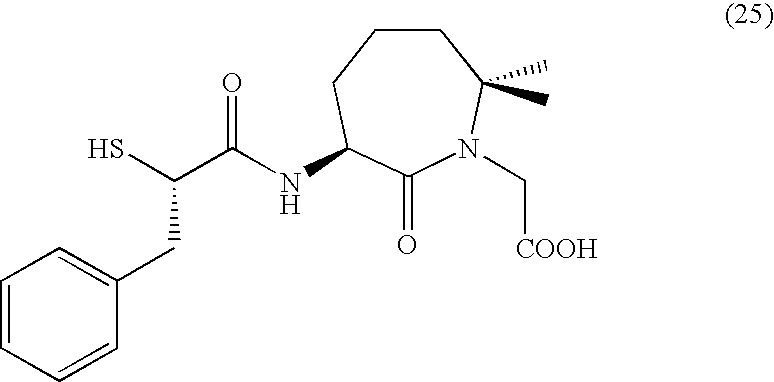Method for producing lysine derivative
a technology of lysine and derivative, which is applied in the direction of biocide, peptide/protein ingredients, bulk chemical production, etc., can solve the problems of many steps and limited production of optically active amino acids
- Summary
- Abstract
- Description
- Claims
- Application Information
AI Technical Summary
Benefits of technology
Problems solved by technology
Method used
Image
Examples
reference example 1
methyl 4-methyl-4-nitropentanoate
[0135] 2-Nitropropane (25 g, 0.28 mol) was dissolved in ethanol (140 ml) and methyl acrylate (25.3 ml, 0.28 mol) and potassium fluoride (1.63 g, 0.028 mol) were added. The mixture was refluxed under heating for 4 h. After cooling, ethanol was evaporated by concentration under reduced pressure, and the residue was extracted with ethyl acetate (100 ml) and water (50 ml). Ethyl acetate was evaporated under reduced pressure to give the objective compound (40.6 g, yield 82.5%).
[0136]1H-NMR(CDCl3) δ ppm: 1.60(s,6H), 2.22-2.38(m,4H), 3.70(s,3H)
reference example 2
4-methyl-4-nitropentanol
[0137] Methyl 4-methyl-4-nitropentanoate (17.5 g, 0.1 mol) was dissolved in ethanol (200 ml) and cooled to 5° C., after which sodium borohydride (7.55 g, 0.2 mol) was added. The mixture was stirred at room temperature for 1 h, and at 50° C. for 3 h. Water (100 ml) and hydrochloric acid were added to adjust the pH to 3, and ethanol was evaporated by concentration under reduced pressure. The residue was extracted with ethyl acetate (250 ml) and water (100 ml) and washed with saturated brine. Ethyl acetate was evaporated by concentration under reduced pressure to give the objective compound (14.7 g, yield 91.2%).
[0138]1H-NMR(CDCl3) δ ppm: 1.5(m,2H), 1.61(s,6H), 1.95-2.05(m,2H), 3.65(t,2H)
reference example 3
4-methyl-4-nitropentanol methanesulfonate
[0139] 4-Methyl-4-nitropentanol (4.3 g, 29.2 mmol) was dissolved in methylene chloride (100 ml) and triethylamine (6.1 ml, 43.8 mmol) was added, which was followed by ice-cooling. Methanesulfonyl chloride (2.94 ml, 38.0 mmol) was added and the mixture was stirred for 1 h under ice-cooling. The mixture was washed with water (50 ml), 0.5 mol / L hydrochloric acid (50 ml), 5% aqueous sodium hydrogencarbonate solution (50 ml) and saturated brine (50 ml). Methylene chloride was evaporated by concentration under reduced pressure and the residue was subjected to crystallization with ethyl acetate (4 ml) and n-hexane (20 ml). After filtration, the residue was dried under reduced pressure at 40° C. to give the objective compound (6.17 g, yield 93.8%).
[0140] H-NMR(CDCl3) δ ppm: 1.62(s,6H), 1.70-1.80(m,2H), 2.05(dd,2H), 3.06(s,3H), 4.23(t,2H)
[0141] mass spectrum m / e: 243(M+NH4+)
PUM
| Property | Measurement | Unit |
|---|---|---|
| temperature | aaaaa | aaaaa |
| temperature | aaaaa | aaaaa |
| pH | aaaaa | aaaaa |
Abstract
Description
Claims
Application Information
 Login to View More
Login to View More - R&D
- Intellectual Property
- Life Sciences
- Materials
- Tech Scout
- Unparalleled Data Quality
- Higher Quality Content
- 60% Fewer Hallucinations
Browse by: Latest US Patents, China's latest patents, Technical Efficacy Thesaurus, Application Domain, Technology Topic, Popular Technical Reports.
© 2025 PatSnap. All rights reserved.Legal|Privacy policy|Modern Slavery Act Transparency Statement|Sitemap|About US| Contact US: help@patsnap.com



